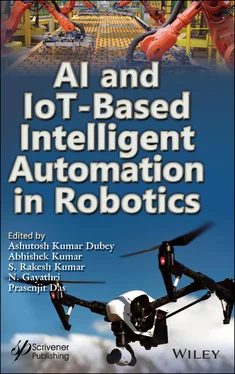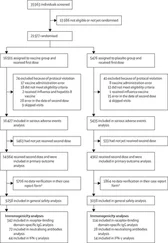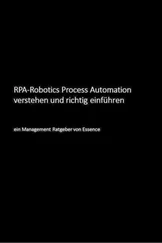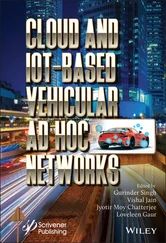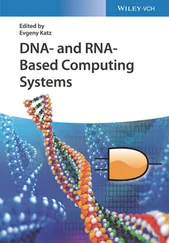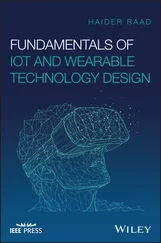© 2021 Scrivener Publishing LLC
For more information about Scrivener publications please visit www.scrivenerpublishing.com.
All rights reserved. No part of this publication may be reproduced, stored in a retrieval system, or transmitted, in any form or by any means, electronic, mechanical, photocopying, recording, or otherwise, except as permitted by law. Advice on how to obtain permission to reuse material from this title is available at http://www.wiley.com/go/permissions.
Wiley Global Headquarters
111 River Street, Hoboken, NJ 07030, USA
For details of our global editorial offices, customer services, and more information about Wiley products visit us at www.wiley.com.
Limit of Liability/Disclaimer of Warranty
While the publisher and authors have used their best efforts in preparing this work, they make no representations or warranties with respect to the accuracy or completeness of the contents of this work and specifically disclaim all warranties, including without limitation any implied warranties of merchant-ability or fitness for a particular purpose. No warranty may be created or extended by sales representatives, written sales materials, or promotional statements for this work. The fact that an organization, website, or product is referred to in this work as a citation and/or potential source of further information does not mean that the publisher and authors endorse the information or services the organization, website, or product may provide or recommendations it may make. This work is sold with the understanding that the publisher is not engaged in rendering professional services. The advice and strategies contained herein may not be suitable for your situation. You should consult with a specialist where appropriate. Neither the publisher nor authors shall be liable for any loss of profit or any other commercial damages, including but not limited to special, incidental, consequential, or other damages. Further, readers should be aware that websites listed in this work may have changed or disappeared between when this work was written and when it is read.
Library of Congress Cataloging-in-Publication Data
ISBN 978-1-119-71120-9
Cover image: Pixabay.Com
Cover design by Russell Richardson
Set in size of 11pt and Minion Pro by Manila Typesetting Company, Makati, Philippines
Printed in the USA
10 9 8 7 6 5 4 3 2 1
It is widely believed that the current technologies are not the only factors that limits the building of an efficient human-machine intelligent processing engine. The emotions and the cognitive abilities are also playing an important role in understanding the various aspects through various intelligent technologies.
Artificial Intelligence (AI) is one of the trending technologies in the recent era. The emergence of the robotics and application of AI in it brings out a significant change in the domain. Various algorithms that emerge in AI and the computational efficiency of the systems has made it possible to address a number of applications through robotics. The Internet of Things (IoT) is the important domain that plays a major role in robotics. With the aid of IoT and AI, robotics an exponential development in providing solutions to complex technical problems have been explored.
This book aims at providing an overview of robotics and the application of AI and IoT in robotics. It contains the deep exploration of AI and IoT based intelligent automation in robotics. The various algorithms and frameworks for robotics based on AI and IoT have been presented analyzed and discussed. This book also provides insights on application of robotics in education, healthcare, defense and many other fields with the utilization of IoT and AI. It also includes the idea of smart cities using robotics.
This book contains twenty-four chapters. Chapter 1reports the introduction about the robotics. Chapter 2explores the techniques of robotics for automation using AI and IoT. Chapter 3descriptively investigates the role of the defense in the same technological aspects. Chapter 4examines the role of AI and IoT based intelligent automation of robotics in case of healthcare. Chapter 5explores the skill transfer to robots based on semantically represented the activities of humans. Chapter 6illustrates the healthcare robots enabled with IoT and artificial intelligence for old aged patients. Chapter 7explores the robotics, AI and IoT in defense system. Chapter 8describes the techniques of robotics for automation using AI and IoT. Chapter 9discusses an artificial intelligence based smart task responder that is android robot for human instruction using LSTM technique. Chapter 10explores the robotics, AI and IoT in medical and healthcare. Chapter 11scrutinizes real time mild and moderate Covid’19 human body temperature detection using AI. Chapter 12shows the role of drones in smart cities. Chapter 13presents UAV’s in terms of agriculture prospective. Chapter 14discussed the semi-automated parking system by using DSDV and RFID. Chapter 15reviews on the various technologies involved in vehicle to vehicle communication. Chapter 16explores about the smart wheelchair. Chapter 17explores defaulters list using facial recognition. Chapter 18introduces visitor/intruder monitoring system using machine learning. Chapter 19provides a comparison of machine learning algorithms for air pollution monitoring system. Chapter 20discusses a novel approach towards audio watermarking using FFT and Cordic Q-R decomposition. Chapter 21explores the performance of DC biased optical orthogonal frequency division multiplexing in visible light communication. Chapter 22illustrates the microcontroller based variable rate syringe pump for microfluidic application. Chapter 23illustrates the analysis of emotion in speech signal processing and rejection of noise. Chapter 24discusses regarding securing cloud data by using blend cryptography with AWS services.
Overall, this book is designed for exploring global technological information about the AI and IoT based intelligent automation in robotics. Armed with specific usage practices, applicability, framework and challenges readers can make informed choices about the adoption of AI and IoT based intelligent automation. It may be helpful in the development of efficient framework and models in the adoption of these techniques in different domains.
It is a great pleasure for us to acknowledge the contributions and assistance of many individuals. We would like to thank all the authors who submitted chapters for their contributions and fruitful discussion that made this book a great success. We hope the readers find value and future insights into the contributions made by the authors. This book also opens up further avenues and opportunities for the future research. We are very thankful to the team of Scrivener publishing specially to Martin Scrivener for providing the meticulous service for timely publication of this book. We would like to express our deep sense of gratitude for the encouragement and support offered by our Institutions/Universities and colleagues. Last but not least, we gratefully acknowledge the support, encouragement and patience of our families.
Ashutosh Kumar DubeyAbhishek Kumar S. Rakesh Kumar N. Gayathri Prasenjit DasFebruary 2021
1
Introduction to Robotics
Srinivas Kumar Palvadi1, Pooja Dixit2 and Vishal Dutt3*
1Department of Computer Science Engineering, University of Madras, Chennai, Tamil Nadu, India
2Sophia Girls’ College (Autonomous), Ajmer, Rajasthan, India
3Department of Computer Science, Aryabhatta College, Ajmer, Rajasthan, India
Читать дальше
